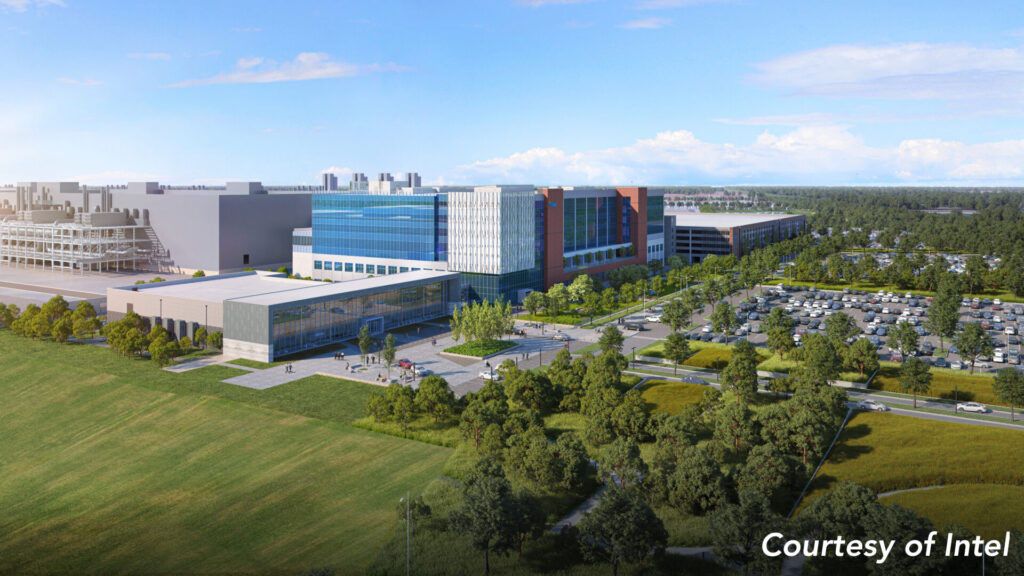Biden-Harris Administration Announces Preliminary Terms with Intel to Support Investment in U.S. Semiconductor Technology Leadership and Create Tens of Thousands of Jobs
U.S. Department of Commerce Proposes up to $8.5 Billion in Potential Direct Funding for Intel Under President Biden’s Investing in America Agenda to Support Multiple Projects in Arizona, New Mexico, Ohio, and Oregon
Today, the Biden-Harris Administration announced that the U.S. Department of Commerce and Intel Corporation have reached a non-binding preliminary memorandum of terms (PMT) to provide up to $8.5 billion in direct funding under the CHIPS and Science Act to strengthen the U.S. supply chain and re-establish American leadership in semiconductor manufacturing. Leading-edge logic chips are essential to the world’s most advanced technologies like artificial intelligence, and this proposed funding would help ensure more of those chips are developed and made domestically. As President Biden highlighted in his State of the Union, the CHIPS and Science Act is charting a new course to manufacture critical technologies in America, lead the world in innovation, and create good jobs here in the United States. This is the Department of Commerce’s fourth PMT announcement under the CHIPS and Science Act.
Over the course of the next five years, Intel expects its investments in the United States to exceed $100 billion, as it expands capacity and capabilities in Arizona, New Mexico, Ohio, and Oregon, estimated to directly create over 10,000 manufacturing jobs and nearly 20,000 construction jobs. The Biden Administration’s proposed CHIPS investment, coupled with Intel’s investment, would mark one of the largest investments ever announced in U.S. semiconductor manufacturing. The PMT also includes approximately $50 million in dedicated funding to develop the company’s semiconductor and construction workforce. This builds upon Intel’s own workforce investments, totaling over $250 million in the past five years, as well as its strong partnerships with local communities, community colleges, universities, Historically Black Colleges and Universities (HBCUs), and apprenticeship programs.
“There is no one who cares more about revitalizing American manufacturing than President Biden, and today’s announcement is a massive step towards ensuring America’s leadership in manufacturing for the 21st century. With this agreement, we are helping to incentivize over $100 billion in investments from Intel – marking one of the largest investments ever in U.S. semiconductor manufacturing, which will create over 30,000 good-paying jobs and ignite the next generation of innovation,”
said U.S. Secretary of Commerce Gina Raimondo. “This announcement is the culmination of years of work by President Biden and bipartisan efforts in Congress to ensure that the leading-edge chips we need to secure our economic and national security are made in the U.S.”
Leading-edge chips power the most sophisticated technology on the planet, including developing AI and building critical military capabilities. Intel’s process technologies such as Intel 18A and advanced packaging technologies, combined with its foundry services, would better enable U.S. companies to lead the AI industry by ensuring we have a domestic supply of these advanced chips.
“The CHIPS for America program will bring semiconductor manufacturing back to the U.S. and create a vital R&D ecosystem to keep it here,”
said Under Secretary of Commerce for Standards and Technology and NIST Director Laurie E. Locascio. “The innovation sparked by this proposed investment would strengthen America’s technological and research leadership and significantly help enhance our nation’s manufacturing capacity while strengthening communities and creating good-paying jobs.”
“Today is a defining moment for the U.S. and Intel as we work to power the next great chapter of American semiconductor manufacturing innovation,”
said Intel CEO Pat Gelsinger. “AI is supercharging the digital revolution and everything digital needs semiconductors. CHIPS Act support will help to ensure that Intel and the U.S. stay at the forefront of the AI era as we build a resilient and sustainable semiconductor supply chain to power our nation’s future.”
This proposed investment would deliver on the Administration's commitment to developing a robust domestic semiconductor ecosystem by reinforcing Intel's decades-long history in the United States. The investment will also enable the company to support industry-leading, U.S.-based fabless semiconductor companies with U.S.-based leading-edge production. The proposed CHIPS funding would strengthen all major technical processes for leading-edge chips to occur in the United States, including proposed investments in:
- Chandler, Arizona: Construction of two new leading-edge logic fabs and modernization of one existing fab, significantly increasing leading-edge logic capacity, including high volume domestic production of Intel 18A – the company’s most advanced chip design that enables higher performing, leading-edge chips through RibbonFET gate-all-around transistors and PowerVia backside power delivery. The company will produce the first Intel 18A product, called Clearwater Forest, at its Arizona facilities. In 2022, Intel partnered with Maricopa County Community Colleges to launch a first-of-its-kind program with Intel employee-instructors to provide students an entry point into semiconductor technician careers. This investment will support 3,000 manufacturing jobs and 6,000 construction jobs.
- Rio Rancho, New Mexico: Modernization of two fabs into advanced packaging facilities to close an important gap in the domestic semiconductor supply chain. When in full production, this facility will be the largest advanced packaging facility in the United States. To support engineering students in New Mexico, Intel established endowment scholarships at five colleges and universities and has supported STEAM education through investments, annual grants, and hands-on learning kits benefitting students living on indigenous lands. This investment will support 700 manufacturing jobs and 1,000 construction jobs.
- New Albany, Ohio: Creation of a new regional chipmaking ecosystem, anchored by the construction of two leading-edge logic fabs, expanded leading-edge foundry capacity, and supply chain diversification. Intel has devoted significant resources to develop a pipeline of skilled workers in Ohio, funding over 80 institutions of higher education across the state, including community colleges, HBCUs, and universities. As part of this investment in Ohio, Intel’s design and build partner Bechtel signed a Project Labor Agreement (PLA) with the North America Building Trades Unions for the construction of the two facilities. This investment will support 3,000 manufacturing jobs and 7,000 construction jobs.
- Hillsboro, Oregon: Investment in the premier hub of leading-edge development in the United States through the expansion and modernization of technology development facilities that will utilize the world’s first High NA EUV lithography equipment. The Gordon Moore Park campus at Ronler Acres in Hillsboro, Oregon is the heart of Intel’s innovation hub for leading-edge semiconductor research and technology development in the United States. These investments will further the company’s technological leadership and enable the continued development of new innovations. In 2022, Intel spent more than $4 billion with more than 500 suppliers across Oregon. This investment will support several thousand manufacturing and construction jobs.
Intel currently uses 100% renewable electricity in U.S. fabs and has achieved net-positive water status in its U.S. operations through efficient water management, water reuse, and, in collaboration with local communities, investment in water restoration in local watersheds. In addition, as part of its broader workforce investment program, Intel has committed to providing affordable, accessible, high-quality child care for its workers across its facilities. For U.S. employees, Intel will be increasing the reimbursement amount and duration for its back-up care program and adding additional access to discounted primary child care providers, as well as access to a vetted network of child care providers. In addition, Intel will pilot a primary child care reimbursement program for non-exempt employees.
In addition to the proposed direct funding of up to $8.5 billion, the CHIPS Program Office would make up to $11 billion in loans – which is part of the $75 billion in loan authority provided by the CHIPS and Science Act – available to Intel under the PMT. The company has indicated that it is planning to claim the Department of the Treasury’s Investment Tax Credit, which is expected to be up to 25% of qualified capital expenditures.
As explained in its first
Notice of Funding Opportunity (NOFO), the Department may offer applicants a PMT on a non-binding basis after satisfactory completion of the merit review of a full application. The PMT outlines key terms for a CHIPS incentives award, including the amount and form of the award. The award amounts are subject to due diligence and negotiation of a long-form term sheet and award documents and are conditional on the achievement of certain milestones and remain subject to availability of funds. After the PMT is signed, the Department begins a comprehensive due diligence process on the proposed projects and continues negotiating or refining certain terms with the applicant. The terms contained in the long-form term sheet and the final award documents may differ from the terms of the PMT being announced today.
About CHIPS for America
The Department has received more than 620 statements of interest, more than 170 pre-applications and full applications for NOFO 1, and more than 160 small supplier concept plans for NOFO 2. The Department is continuing to conduct rigorous evaluation of applications to determine which projects will advance U.S. national and economic security, attract more private capital, and deliver other economic benefits to the country. The announcement with Intel is the fourth PMT announcement the Department of Commerce has made under the CHIPS and Science Act, with additional PMT announcements expected to follow throughout 2024.
CHIPS for America is part of President Biden’s economic plan to invest in America, stimulate private sector investment, create good-paying jobs, make more in the United States, and revitalize communities left behind. CHIPS for America includes the CHIPS Program Office, responsible for manufacturing incentives, and the CHIPS Research and Development Office, responsible for R&D programs, that both sit within the National Institute of Standards and Technology (NIST) at the Department of Commerce. NIST promotes U.S. innovation and industrial competitiveness by advancing measurement science, standards, and technology in ways that enhance economic security and improve our quality of life. NIST is uniquely positioned to successfully administer the CHIPS for America program because of the bureau’s strong relationships with U.S. industries, its deep understanding of the semiconductor ecosystem, and its reputation as fair and trusted. Visit
www.chips.gov to learn more.



